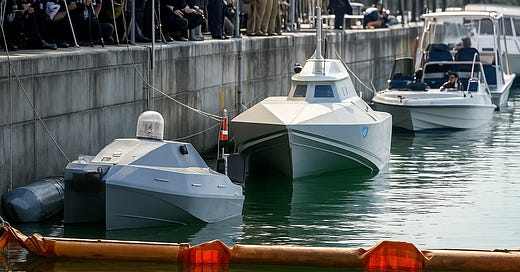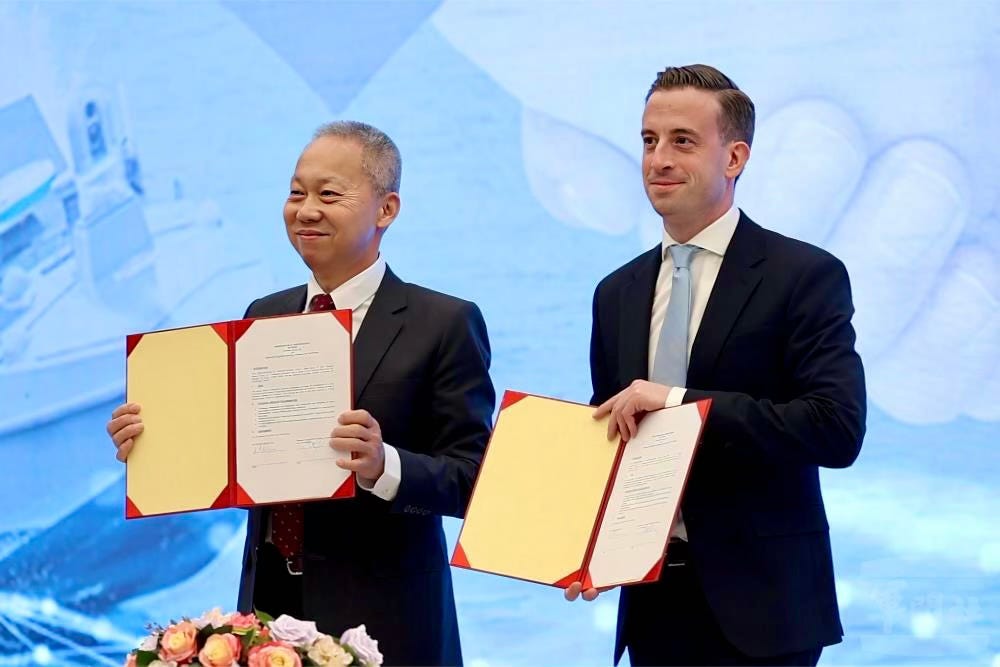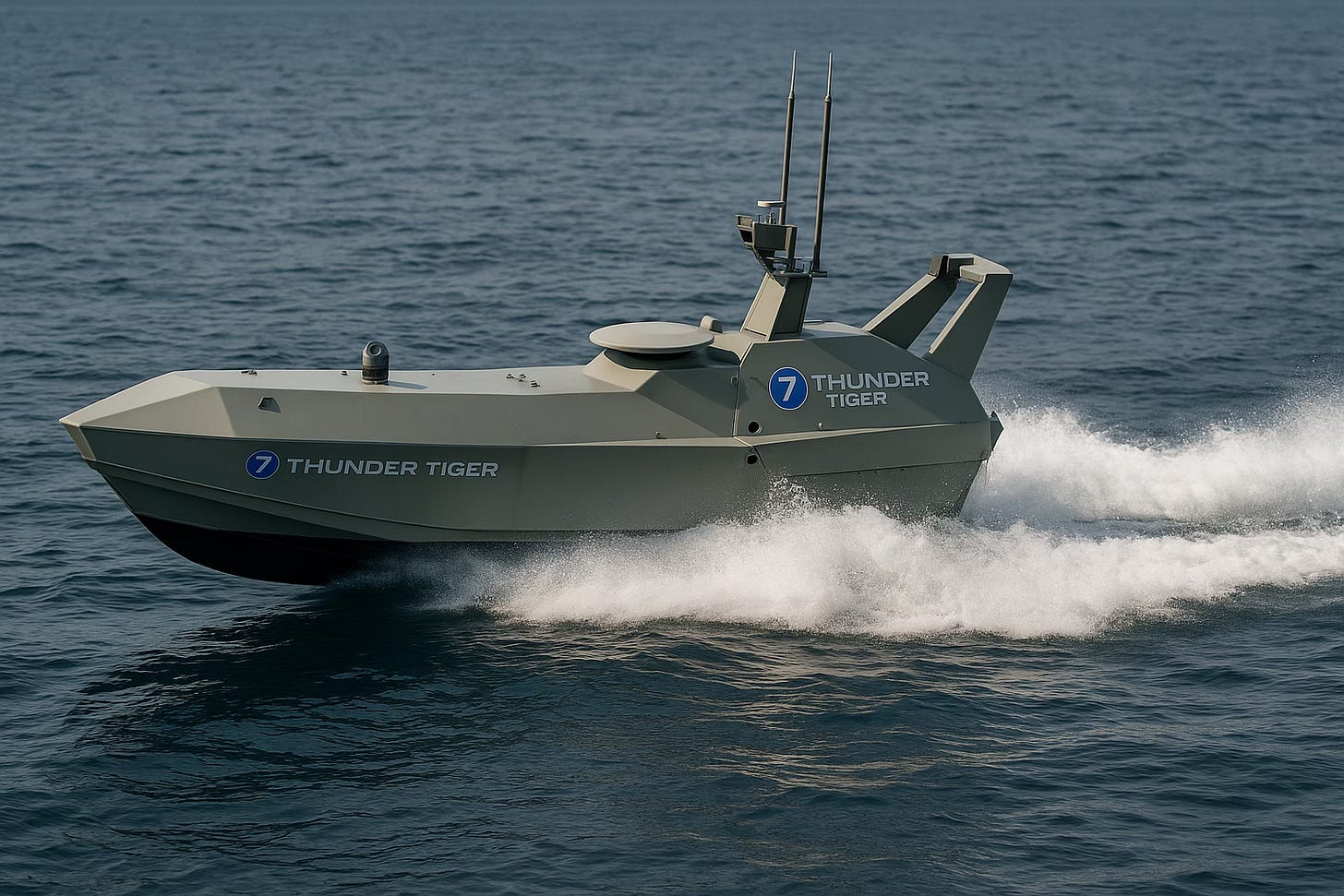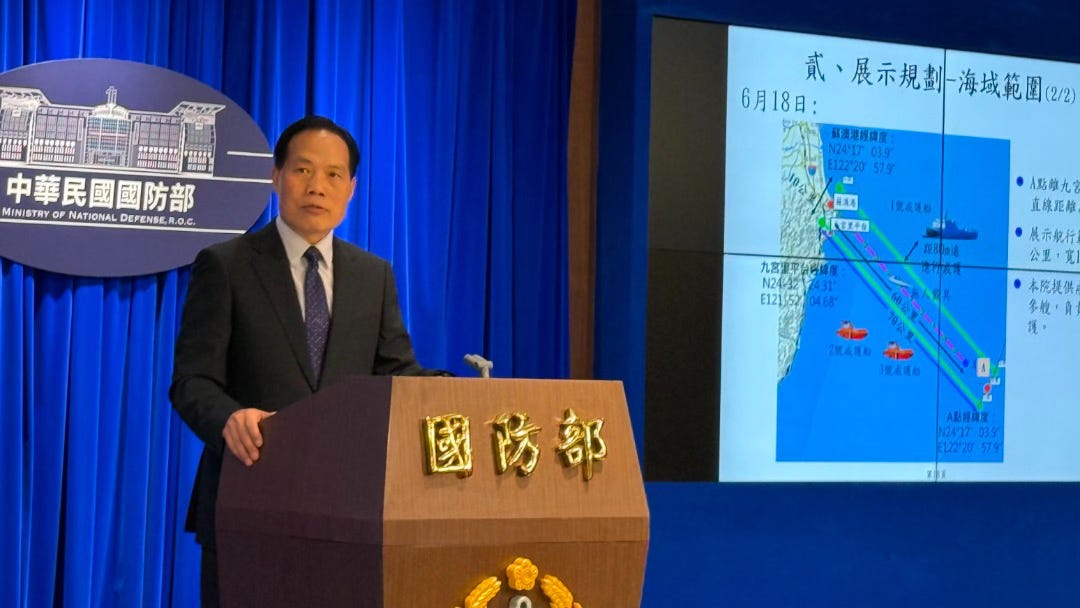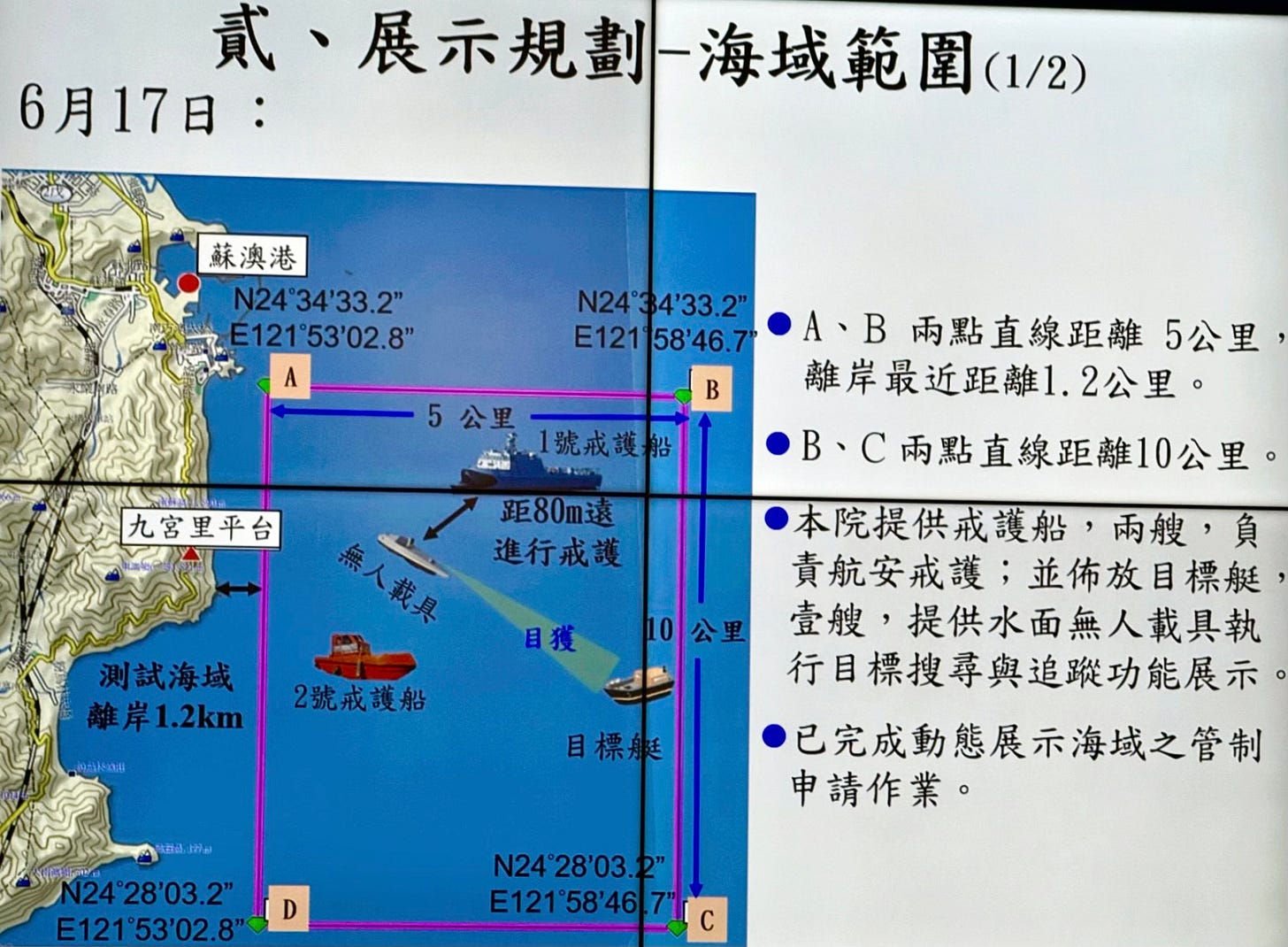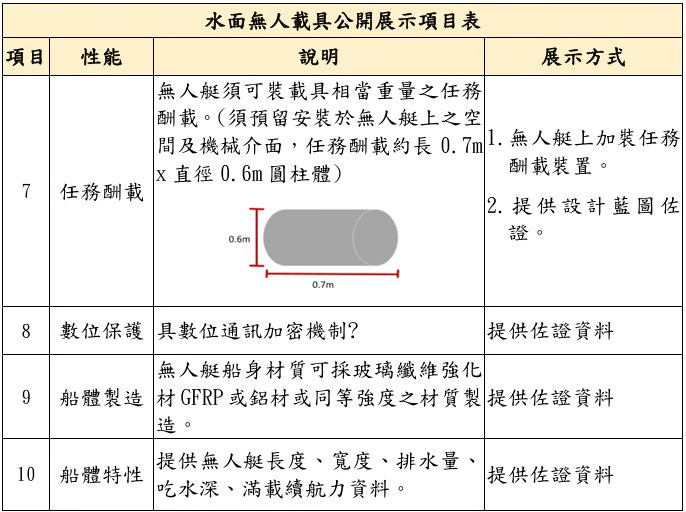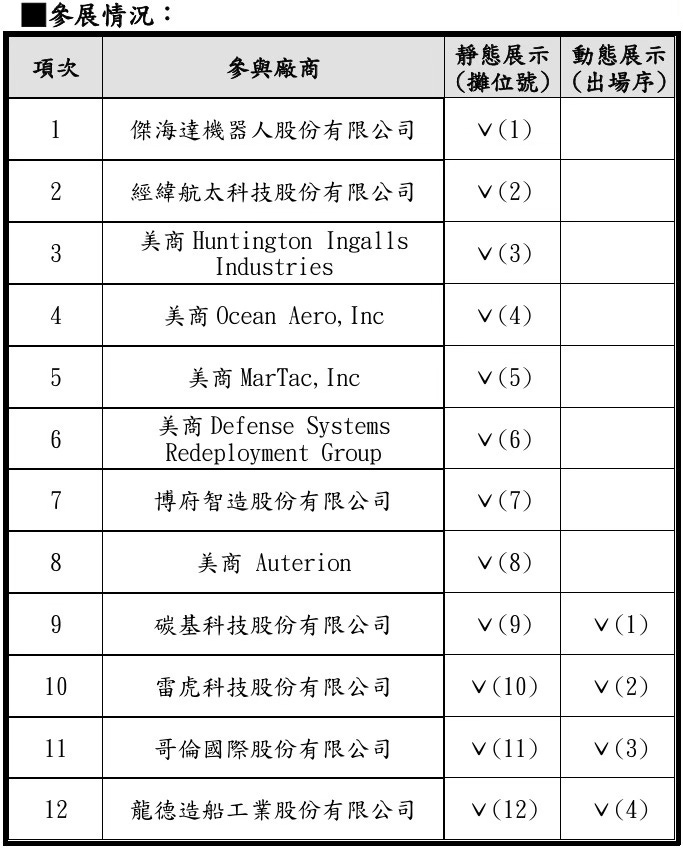Taiwan Unmanned Surface Vessel Trials
Domestic and International Companies Compete for Taiwan Navy Requirement
For those who want to peer into China’s prolific unmanned sea vessels consider: China’s Unmanned Sea Vessels (2025), Chinese Submarines and Underwater Warfare Systems (2019), and Modern Chinese Patrol Boats (2024).
(Photo by Military News Agency reporter Tsai Fang-yun)
China In Arms BOOKSTORE and GIFT SHOP!
Twitter and YouTube Page and LinkedIn
Subscribe: $5 Month/$30 Annual (unable to secure a subscription contact the bank for permission for Stripe deposits).
17 June 2025 (Tuesday)
Taiwan Unmanned Surface Vessel Trials
Domestic and International Companies Compete for Taiwan Navy Requirement
By Wendell Minnick (Whiskey Mike) 顏文德
TAIPEI - Taiwan Ministry of National Defense Press Release (translated by DeepL).
Taiwan Held Public Demonstration of Unmanned Surface Vessels on June 17–18 to Advance Defense Capabilities
SU’AO, June 17, 2025 — By Military News Agency Reporter TSAI Fang-yun
On June 17 and 18, 2025, Taiwan’s National Chung-Shan Institute of Science (NCSIST) organized a two-day public demonstration of Unmanned Surface Vessels (USV) off the coast of Suao, Yilan. The event marked a significant milestone in Taiwan’s effort to modernize its defense technologies and deepen collaboration between the government and private industry.
Timed to align with ongoing national defense initiatives, the demonstration gathered domestic and international USV manufacturers to showcase their latest innovations. Through this platform, NCSIST aimed to provide the military and Coast Guard with valuable performance data, supporting future decisions on procurement, specification refinement, and scalable modular production. The effort reflected Taiwan’s broader strategy to enhance its defense autonomy while driving growth across its industrial base.
Two-Phase Demonstration: Static and Dynamic
On June 17, the event began with a static exhibition, during which participating companies presented technical documentation and promotional videos detailing the capabilities and potential applications of their USV models. This phase focused on introducing system specifications, intended operational roles, and technological differentiators.
The following day, June 18, featured the dynamic portion of the demonstration. Three leading Taiwanese firms—Thunder Tiger Technology, Carbon-Based Technology, and Lungteh Shipbuilding—conducted six live tests at sea. These included remote command-and-control demonstrations and electro-optical imaging exercises. The trials offered practical insights into how USVs perform under real-world conditions, helping military evaluators benchmark the systems against combat and surveillance requirements.
Developing a Standardized Control Framework
Following the demonstrations, NCSIST announced its intent to begin developing a standardized control architecture for surface USVs. Drawing directly from the performance data gathered on June 17 and 18, the Institute laid out plans for a flexible, modular control system that could integrate various mission payloads, including those for patrol, search and rescue, environmental monitoring, and logistics.
The initiative is expected to enhance platform interoperability, simplify future upgrades, and enable mass production that serves both military and civilian needs. Officials emphasized that standardization would play a crucial role in accelerating industrial adoption and improving response capabilities across diverse maritime scenarios.
Commitment to Technological Leadership
In statements made during the event, NCSIST reaffirmed its strategic commitment to staying ahead of global defense trends. The Institute outlined plans to incorporate autonomous navigation, AI-driven decision-making, and intelligent mission execution into the next generation of USVs. These features are aimed at improving route optimization, environmental awareness, and operational adaptability in complex maritime environments.
Through the application of artificial intelligence, NCSIST expects to refine data processing, tactical planning, and mission responsiveness—core capabilities required for future battlefield readiness.
Milestone Collaboration with Auterion
Also announced during the event was a major international partnership. On June 18, NCSIST signed a Memorandum of Understanding (MoU) with Auterion, a global leader in open-source autonomous systems. The agreement will see Auterion’s operating system (AuterionOS) and its AI-enabled drone swarm combat platform (Nemesis) integrated into the next generation of unmanned vehicles jointly developed with Taiwanese defense manufacturers.
This collaboration signaled a new era in Taiwan’s drive toward developing autonomous capabilities across air, sea, and land. It marked a tangible step toward global interoperability and greater innovation within Taiwan’s defense ecosystem.
Photo Caption: Thunder Tiger Technology’s Sea Shark 800 performs a live test during the dynamic phase of the USV demonstration on June 18, 2025. (Photo by Military News Agency reporter Tsai Fang-yun)
CHINA IN ARMS ADDITIONAL ANALYSIS:
Taiwan’s military made the announcement for the USV competition during the Tuesday press conference by the Ministry of National Defense (MND) on 27 May.
Five foreign companies and seven domestic companies would participate in the exhibition and exercise.
Specifications for the trial contenders:
All submissions to the competition must conform to the following specifications: vessels must measure 0.6 meters in beam (19.68 feet) and 7 meters in length (22.96 feet). Hull construction is limited to either aluminum or glass fiber reinforced plastic (GFRP). Additionally, all communication systems must employ encrypted digital transmission, ensuring secure data exchange during operations, electro-optical imaging and remote-control range.
U.S. participants in the competition include Auterion, Defense Systems Redeployment Group (DSRG), Huntington Ingalls Industries (HII), MarTac, Inc., and Ocean Aero, Inc.
GeoSat and JetSea AI are also participating, but details are sketchy.
Of all the participating companies, DSRG may possess a distinct advantage, as its Managing Director and Principal has unique connections and insights into Taiwan’s defense establishment.
Louis Tseng, Managing Director and Principal
Tseng is a US citizen and retired Taiwan Air Force officer where he specialized in military operations management and efficiency. For the past decade, Tseng has been an entrepreneur and consultant in the aerospace and defense sector where his focus is on operations and project management for civil and military aviation infrastructure projects. He has also overseen multi-system integration projects between and among US Federal, US State, and US local governments, including the US Federal Aviation Administration, US Federal Bureau of Investigation, US Customs and Border Protection, Georgia Bureau of Investigation, and numerous international airlines. Tseng is a certified Member of the American Association of Airport Executives and earned an Emory University Business Professional designation. He is also involved in US state and national political activities where he has been elected as a Committee Member of a political party of the US State of Georgia and the Vice Chair of the US 7th Congressional District, Georgia. He holds a Bachelor of Science degree from the Taiwan Air Force Institute of Technology.
Tseng ran as a Republican candidate for Georgia House of Representatives District 97 in the May 22, 2018, primary election. He was defeated in that primary.
DSRG does not manufacture USVs directly, but instead specializes on key subsystems and technologies essential for the operation and integration of unmanned platforms.
The domestic entries included: NCSIST’s Kuai Chi, Thunder Tiger’s Sea Shark 800, Carbon-Based Technology’s Carbon Pioneer No. 1, Corum International’s Piranha, Lung Teh Shipbuilding’s Kuroshio. Also three other companies are participating at some level: Jiehaida Robot Company, Jingwei Hangtai, and Bofu Intelligent Manufacturing Company.
Five foreign USV manufacturers participated: Huntington Ingalls Industries, Ocean Aero, MarTac, Defense Systems Redeployment Group, and Auterion.
Lungteh Shipbuilding, in collaboration with the NCSIST, is actively developing the Hui Long Unmanned Underwater Vehicle (UUV). Open-source imagery and publicly available reports that the vessel is approximately 30 meters in length, 6 meters in height, and 3.6 meters in beam, with an estimated displacement of 100 metric tons. The Hui Long is armed with two forward-mounted torpedo tubes, indicating an offensive operational role, and is fitted with two externally mounted cameras positioned at the forward and aft sections of the sail—presumably for navigation and situational awareness. The Hui Long project was initiated in 2019 with an allocated budget of approximately USD $128 million.
In cooperation with Singapore’s ST Engineering, Lungteh Shipbuilding has produced the Venus 16 USV, designed for a variety of maritime security and surveillance operations.
Together, these programs underscore Lungteh Shipbuilding’s position as the most viable and operationally experienced candidate among Taiwan’s four principal shipbuilders for leading the development and evaluation of UUVs for the Taiwan Navy.
While CSBC Corporation (also known as Taiwan International Shipbuilding Corporation) remains the largest shipbuilder in the country, and Jong Shyn Shipbuilding Company (JSSC) is another key player in naval construction, Lungteh’s proven track record in both USV and UUV platforms—such as the Hui Long UUV and Venus 16 USV—positions it uniquely for this emerging domain.

